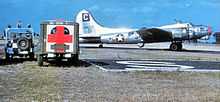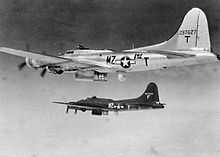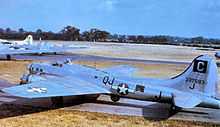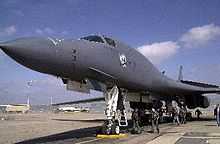96th Test Wing
| 96th Test Wing | |
|---|---|
 96th Test Wing - Emblem | |
| Active | 1942-1945, 1947-1949, 1953-1993, 1994 – present |
| Country | United States |
| Branch | United States Air Force |
| Garrison/HQ | Eglin AFB, Florida |
| Motto |
"E Sempre L'ora" "It Is Always The Hour" |
| Decorations |
|
| Commanders | |
| Notable commanders |
George Lee Butler Merlyn Hans Dethlefsen |
The 96th Test Wing (96 TW) is a United States Air Force formation assigned to the Air Force Test Center, Air Force Material Command (AFMC).[1] It is stationed at Eglin Air Force Base, Florida. The wing is also the host unit at Eglin. The 96th Test Wing consolidated Eglin's 46th Test Wing, which was inactivated and the previously designated 96th Air Base Wing.
The wing is the successor organization to the World War II Eighth Air Force 96th Bombardment Group. A B-17 Flying Fortress unit in England, stationed primarily at RAF Snetterton Heath, the group was the first double-strength group in Eighth Air Force, and led the first shuttle mission to Regensburg on 17 August 1943. Active for over 60 years, the 96th Bombardment Wing was a component organization of Strategic Air Command's deterrent force during the Cold War, as a strategic bombardment wing.
History
World War II




Constituted as 96th Bombardment Group (Heavy) on 28 January 1942. Activated on 15 July 1942. Trained with B-17's and also served as an operational training unit. Moved to RAF Grafton Underwood England, April–May 1943, for duty with Eighth Air Force. The group was assigned to the 45th Combat Bombardment Wing of the 3d Bombardment Division. Its tail code was Square-C. The group consisted of the following squadrons:
- 337th Bombardment Squadron (QJ)
- 338th Bombardment Squadron (BX)
- 339th Bombardment Squadron (AW)
- 413th Bombardment Squadron (MZ)
This group commenced combat operations on 14 May but, as it was assigned to the 45th Wing with a general base area in north Essex, the 96th moved east at the end of May to RAF Andrews Field. The 96th appears to have only carried out one mission while based at Andrews Field. On 29 May 1943 they took part in a raid on Rennes naval storage depot from which one B-17 failed to return. The group was moved to RAF Snetterton Heath on 12 June 1943 in a general exchange of bases with B-26 Marauder groups.
As the most conveniently reached station from 3rd Division Headquarters at Elveden Hall, Snetterton Heath units often led to major operations carrying commanding generals. General Curtis LeMay led the famous Regensburg shuttle mission to North Africa flying out of this base, and received a Distinguished Unit Citation for withstanding severe assaults by enemy fighters. The 96th also led the 3rd Division on the famous Schweinfurt mission of 14 October 1943. In addition, the 93d attacked shipyards, harbours, railway yards, aerodromes, oil refineries, aircraft factories, and other industrial targets in Germany, France, the Netherlands, Belgium, Norway, Poland, Hungary, and Czechoslovakia.
The 96th received another DUC for leading the 45th Bomb Wing a great distance through heavy clouds and intense anti-aircraft fire to raid important aircraft component factories in Poland on 9 April 1944. Other significant targets included airfields at Bordeaux and Augsburg; marshalling yards at Kiel, Hamm, Brunswick, and Gdynia; aircraft factories at Chemnitz, Hanover, and Diósgyőr; oil refineries at Merseburg and Brux, and chemical works in Wiesbaden, Ludwigshafen, and Neunkirchen.
In addition to strategic operations, missions of the 96th BG included bombing coastal defences, railway bridges, gun emplacements, and field batteries in the battle area prior to and during the invasion of Normandy in June 1944; attacking enemy positions in support of the breakthrough at Saint-Lô in July 1944; aiding the campaign in France in August by striking roads and road junctions, and by dropping supplies to the Maquis; and attacking, during the early months of 1945, the communications supplying German armies on the western front.
After V-E Day, the group was scheduled for occupation duties in Germany however plans were revised and the 96th BG flew food to the Netherlands and hauled redeployed personnel to French Morocco, Ireland, France, and Germany. In November 1945 its aircraft were flown back to the United States, and its squadrons were inactivated. The ground personnel left Snetterton Heath in early December, arriving at Camp Kilmer New Jersey.
The 96th Bomb Group was inactivated on 20 December 1945.
Cold War

The 96th Bomb Group was activated in the Reserves on 29 May 1947 at Gunter AFB, Alabama. Conducted routine training activities. Inactivated on 27 July 1949.
Established again on 6 November 1953 at Altus AFB, Oklahoma, as the 96th Bombardment Wing, Medium. It was activated 8 November. Wing headquarters and most of the wing components were not manned until March 1954; those components manned were controlled by the 96th Air Base Group, whose commander served additional duty as the 96th's wing commander.[2] The wing soon received KC-97 Stratotankers and began air refueling operations in March 1954.
Began receiving new B-47E Stratojet swept-wing medium bombers in April 1955, capable of flying at high subsonic speeds and primarily designed for penetrating the airspace of the Soviet Union. Began bombardment training in April 1955 in support of SAC's global commitments. Deployed to Andersen AFB Guam, January–April 1957. Upon activation, the Wing was bestowed the lineage, legacy and honors of the USAAF World War II 96th Bomb Group.
Transferred to Dyess AFB, Texas on 8 September 1957
Controlled the 4th Strategic Support Squadron, a strategic airlift squadron, September 1959 – March 1961, and the 578th Strategic Missile Squadron, an Atlas F missile squadron, July 1961 – March 1965. The first Atlas missile went on alert in April 1962. The Atlas was phased out in March 1965.
In the early 1960s, the B-47 was considered to be reaching obsolescence, and was being phased out of SAC's strategic arsenal. In 1963, its three squadrons of B-47s (338th, 339th, 413th Bomb Squadrons) were replaced by one squadron (337th Bomb Squadron) of B-52s. The 96th received B-52Cs from the 99th Bomb Wing, then new B-52Ds and B-52Es from Boeing. It was redesignated the 96th Bombardment Wing, Heavy, on 31 March 1972. During several months of 1970, and for a lengthy period in 1972–1973, all wing aircraft, crews, and most support personnel were loaned to other SAC organizations based in the Far East or Southeast Asia for combat operations.
From 1980, the wing's 917th Air Refueling Squadron KC-135A aircraft regularly deployed to Europe, Alaska, and the Pacific to support SAC tanker task force requirements.
The 337th Bomb Squadron became the first squadron to operate the B-1B Lancer, after the arrival of the first aircraft in June 1985. In addition, the 338th Combat Crew Training Squadron (CCTS) received B-1Bs in June 1992. In October 1986, B-1Bs assumed SAC alert duties for the first time.
Wing 917th ARS KC-135 tankers provided refueling support to units involved in the invasion of Panama, December 1989. Ferried personnel and equipment to Andersen AFB, Guam for further movement to Southwest Asia, in August 1990. In December 1990 all remaining tanker aircraft and crews, except those on alert duty, were sent to Incirlik AB Turkey in support of Operation Desert Storm.
Post Cold War

On 1 September 1991, the wing was redesignated as the 96th Wing and implemented the objective wing concept. It was relieved from assignment to SAC and assigned to Air Combat Command on 1 June 1992. Also on 1 June 1992, the 917 ARS acquired KC-135Qs in conjunction with the drawdown of tanker operations at Beale AFB, California.
In accordance with the realignment of tanker squadrons to Air Mobility Command, the 917 ARS was reassigned to the 43d Operations Group at Malmstrom AFB, Montana on 30 September 1993.
On 1 October 1993 the 96th Wing inactivated, replaced by the 7th Wing (7 WG), which was moved without personnel or equipment due to the BRAC transfer of Carswell AFB, Texas to the U.S. Navy and its redesignation as Naval Air Station Joint Reserve Base Fort Worth/Carswell Field. The B-1Bs of the 337th BS were reassigned to the 7 WG, and the 337h BS was reorganized and absorbed the B-1s of the inactivating 338 Crew Training Squadron as part of the new wing.
The 96th Air Base Wing stood up as a non-flying organization on 15 March 1994. It assumed the mission of supporting the Air Armament Center and associate units at Eglin AFB, Florida.
2012 Air Force Material Command Restructuring
The wing was redesignated as the 96th Test Wing (merging the 96th Air Base Wing and the 46th Test Wing together), as part of the 2012 Air Force Material Command Restructuring. It is the test and evaluation unit for Air Force air-delivered weapons, navigation and guidance systems, Command and Control systems and Air Force Special Operations Command systems.[citation needed]
The wing provides expert evaluation and validation of the performance of systems throughout the design, development, acquisition, and sustainment process to ensure the warfighter has technologically superior, reliable, maintainable, sustainable and safe systems. The 96th TW performs developmental test and evaluation across the complete system life cycle for a wide variety of customers including: Air Force Systems Program Offices, the Air Force Research Laboratory, logistics and product centers; major commands; other DoD services and U.S. government agencies (Department of Transportation, NASA, etc.); foreign military sales; and private industry.
Additionally the wing commander serves as the installation commander, supporting Team Eglin with traditional military services as well as all the services of a small city, including civil engineering, personnel, logistics, communications, computer, medical, security, and all other host services. The Wing provides a myriad of base operating support functions like material resources, mobility requirements, and meeting the needs of Eglin personnel.
There are seven distinct groups in the wing (see groups below), the Air Force Seek Eagle Office and more than 30 squadrons and divisions.
Lineage
Group
- Constituted as 96th Bombardment Group (Heavy), on 28 January 1942
- Activated on 15 July 1942
- Redesignated as 96th Bombardment Group, Heavy on 20 August 1943
- Inactivated on 21 December 1945
- Redesignated as: 96th Bombardment Group, Very Heavy, on 13 May 1947
- Activated in the Reserve on 29 May 1947
- Inactivated on 27 June 1949
- Consolidated with the 96th Bombardment Wing, Heavy on 31 January 1984 as the 96th Bombardment Wing, Heavy[3]
Wing
- Constituted as: 96th Bombardment Wing, Medium, on 6 November 1953.
- Activated on 18 November 1953.
- Redesignated as: 96th Strategic Aerospace Wing, on 1 April 1962
- Redesignated as: 96th Bombardment Wing, Heavy, on 31 March 1972
- Consolidated with the 96th Bombardment Group, Heavy on 31 January 1984
- Redesignated as: 96th Wing, on 1 September 1991
- Inactivated 1 October 1993
- Activated and redesignated 96th Air Base Wing, on 15 March 1994[3]
- Redesignated as: 96th Test Wing, on 18 July 2012
Components
Groups
- 96th Operations Group: 1 September 1991 – 1 October 1993. Seemingly reformed in June–July 2012. Officially reformed 1 October 2012 from the 46th Operations Group.
- Conducts the wing's primary missions of developmental testing and evaluation of conventional munitions, command and control systems, F-15 and A-10 avionics, and navigation and guidance systems. The 96 TW manages 41 modified test aircraft.
- 96th Maintenance Group (earlier 96th Logistics Group),[4] 1 September 1991 – 1 October 1993.
- 96th Test Group
- Operates at Holloman Air Force Base, New Mexico. The Group's mission is to operate test facilities for high speed sled track testing, navigation and guidance system testing, radar signature measurements, weapon systems flight testing, and Air Force Liaison for all AF programs tested at White Sands Missile Range (WSMR).
- 96th Mission Support Group (earlier 96th Air Base Group, 96th Combat Support Group, 96th Support Group) 18 November 1953 – 12 December 1957, 25 June 1961 – 1 October 1993, 15 March 1994 – present
- Provides Aerospace Expeditionary Force readiness, fuels, supply, transportation, ground combat training, security, communication, personnel, education, family services, lodging, food service, recreation and logistics planning and deployment support to approximately 20,000 Team Eglin military and civilian personnel and 43,000 retirees. It deploys combat ready forces in support of worldwide contingency operations.
- 96th Civil Engineer Group 15 March 1994 – present
- Provides engineering forces to support global aerospace forces in peace and war. It operates, maintains, and protects the physical plant, infrastructure, facilities and systems, housing, and the environment, and maintains the largest base in the Air Force - 11.6 million square feet of physical plant and 3,256 facilities.
- 96th Range Group
- Operates the Eglin Gulf Test Range. Consists of approximately 120,000 square miles of overwater airspace, covering the eastern third of the Gulf of Mexico from the Florida panhandle to the Florida Keys. The land range covers 724 square miles and contains 70 specific test and training areas, including an approved depleted uranium test range and the only qualified air-to-ground supersonic range east of the Mississippi River.
- 96th Medical Group (earlier 819th Medical Group; USAF Hospital, Dyess; 96th Strategic Hospital) 1 November 1958 – 1 October 1993, 15 March 1994 – present
- Ensures optimal health for all of Team Eglin. It manages and provides comprehensive, cost-effective health care for 83,000 eligible beneficiaries. It operates a community-based teaching hospital with graduate level programs in family practice, general dentistry and other medical disciplines. It has deployable elements.
Squadrons
- 4th Strategic Support: 1 September 1959 – 15 March 1961
- 11th Air Refueling: attached 16 December 1957 – March 1958
- 96th Air Refueling Squadron: 18 November 1953 – 3 December 1957 (detached 5 October-20 November 1954, 1 August-14 September 1955, 18–31 January 1956, 25 June-9 October 1956, and 10 January-7 April 1957)
- 321st Air Refueling: attached 3 July-8 November 1954
- 337th Bombardment Squadron: 15 July 1942 – 29 November 1945; 29 May 1947 – 27 June 1949; 18 November 1953 – 15 March 1963; 15 September 1963 – 1 September 1991.
- 338th Bombardment (later, 338th Strategic Bombardment Training; 338th Combat Crew Training) Squadron: 15 July 1942 – 15 December 1945; 29 May-8 October 1947; 18 November 1953 – 15 March 1963; 1 July 1986 – 1 September 1991
- 339th Bombardment Squadron: 15 July 1942 – 29 November 1945; 29 May-8 October 1947; 18 November 1953 – 15 March 1963
- 380th Air Refueling: attached 8 November 1954 – 1 April 1955
- 413th Bombardment Squadron: 15 July 1942 – 19 December 1945; 17 July 1947 – 27 June 1949; 1 November 1958 – 1 January 1962
- 546th Bombardment Squadron: 16 July 1947 – 27 June 1949
- 547th Bombardment Squadron: 16 July 1947 – 27 June 1949
- 578th Strategic Missile Squadron: 1 July 1961 – 25 March 1965
- 917th Air Refueling Squadron: attached 1–14 January 1965, assigned 15 January 1965 – 1 September 1991
- 4018th Combat Crew Training: 15 March 1985 – 1 July 1986.
Stations Assigned
|
|
Major Weapons Systems
- Boeing B-17 Flying Fortress (1943–1945)
- Boeing KC-97 Stratotanker (1954–1958)
- Boeing B-47 Stratojet (1955–1963)
- Douglas C-124 Globemaster II (1959–1961)
- Convair SM-65 Atlas ICBM (1962–1965)
- Boeing B-52 Stratofortress (1963–1985)
- Boeing KC-135 Stratotanker (1965–1993)
- Rockwell B-1 Lancer (1985–1993)
- Fairchild Republic A-10 Thunderbolt (2012–Present)
- Northrop AT-38 Talon (2012–Present)
- Lockheed Martin C-130 Hercules (2012–Present)
- Boeing F-15 Eagle (2012–Present)
- Lockheed Martin F-16 Fighting Falcon (2012–Present)
- Bell UH-1 Huey (2012–Present)
See also
Notes
![]() This article incorporates public domain material from websites or documents of the Air Force Historical Research Agency.
This article incorporates public domain material from websites or documents of the Air Force Historical Research Agency.
- ↑ AFMC Press Release, "AFMC Prepares for 5-Center Transition", 19 June 2012. Retrieved 26 June 2012
- ↑ Mixer, Ronald E., Genealogy of the STRATEGIC AIR COMMAND, Battermix Publishing Company, 1999 and Mixer, Ronald E., STRATEGIC AIR COMMAND, An Organizational History, Battermix Publishing Company, 2006.
- ↑ 3.0 3.1 AFHRA Factsheet, 96th Air Base Wing. Retrieved 18 September 2012
- ↑ During World War II, this group was active as the 96th Air Base Group (later 96th Service Group, 96th Air Service Group) in the Mediterranean Theater
References
- Freeman, Roger A. (1978) Airfields of the Eighth: Then and Now. After the Battle ISBN 0-900913-09-6
- Freeman, Roger A. (1991) The Mighty Eighth: The Colour Record. Cassell & Co. ISBN 0-304-35708-1
- Freeman, Roger A. (1994) UK Airfields of the Ninth: Then and Now 1994. After the Battle ISBN 0-900913-80-0
- Freeman, Roger A. (1996) The Ninth Air Force in Colour: UK and the Continent-World War Two. After the Battle ISBN 1-85409-272-3
- Maurer, Maurer, ed. (1983) [1961]. Air Force Combat Units of World War II (reprint ed.). Washington, DC: Office of Air Force History. ISBN 0-912799-02-1..
- Maurer, Maurer, ed. (1982) [1969]. Combat Squadrons of the Air Force, World War II (reprint ed.). Washington, DC: Office of Air Force History. ISBN 0-405-12194-6.
- Ravenstein, Charles A. (1984). Air Force Combat Wings, Lineage & Honors Histories 1947-1977. Washington, DC: Office of Air Force History. ISBN 0-912799-12-9..
- Rogers, Brian. (2005). United States Air Force Unit Designations Since 1978. Hinkley, UK: Midland Publications. ISBN 1-85780-197-0..
- USAAS-USAAC-USAAF-USAF Aircraft Serial Numbers—1908 to Present
External links
| |||||||||||||||||||||||||||||||||||||
| |||||||||||||||||||||||||||||||||||||



